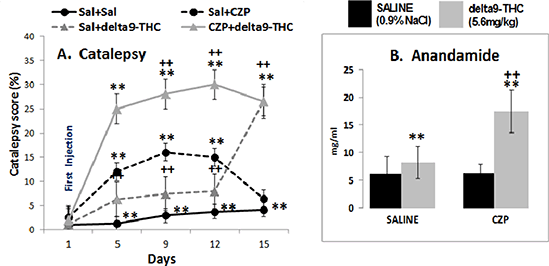| 029P London, UK 8th European Workshop on Cannabinoid Research |
Possible contribution of Cannabinoid CB1 receptors as a pharmacotherapy for clozapine-induced weight gain in rat model of schizophrenia
Introduction: Schizophrenia is a complex psychiatric disorder with a lifetime prevalence of 1% in general populations. The endocannabinoids anandamide and 2-arachydonoylglycerol (2-AG) are lipids naturally derived from membrane precursors which bind cannabinoid receptors. Long-term use of clozapine (CZP) for individuals with schizophrenia carries a high risk for developing metabolic abnormalities, especially clozapine-induced weight gain. The study was designed to investigate the behavioral and metabolic effects of sub-chronic administration of Clozapine (5mg.kg-1) in rats followed by repeated administration of delta9-THC (5.6mg.kg-1). The results were discussed in the context of possible causal link between dopaminergic and cannabinoid signaling system in rat brain as a pharmacotherapy in psychosis.
Method: Locally bred male Albino Wistar rats (n=48) weighing 150+10gm purchased from Dow University of Health Sciences, Pakistan. All procedures were conducted in accordance with NIH guidelines and approved by the Institutional Ethical Committee of University of Karachi, Pakistan. Rats were randomly assigned as: (1) Test group (n=24) received daily CZP (5mg.kg-1) and (2) Control group (n=24) received Saline injections (0.9% NaCl), with an equal volume of 1ml.kg-1 body weight, for four weeks via i.p. drug route. 15-days post-treatment, animals were further subdivided into four groups (n=12 in each group). Delta9-THC (tetrahydrocannabinol) (5.6mg.kg-1) was administered daily for 2 weeks to each group rats. Food intake and body weights were monitored weekly. Behavioral testing was done using bar test for catalepsy and open field arena to determine the antipsychotic-like profile of delta9-THC and CZP. Data were presented as Means+SEM (n=48). Statistical significance was tested using one- or two-way Analysis of Variance (ANOVA) followed by Newman keuls Post hoc test by Graph Pad Prism (6.0) software support. A probability of less than 0.05 was considered statistically significant.
Results: Administration of delta9-THC (5.6mg.kg-1) increased 25% body weight (P<0.01) and exhibited 50% more catalepsy (P<0.01) in CZP (5mg.kg-1) treated rats. Significant increases were observed in cumulative Food intake (F=61.5 P<0.01) and decreased exploratory activity in CZP+delta9-THC group. Co-administration of delta9-THC (5.6mg.kg-1) and CZP (5mg.kg-1) showed increased plasma levels of anandamide (F=85.2 P<0.01), glucose (F=10.8 P<0.01) and Insulin (F=11.0 P<0.01).
Conclusions: It is concluded that 15-day administration of CB1 receptor agonist delta9-THC (5.6mg.kg-1) exacerbate the feeding behavior in CZP treated rats and demonstrate weight gain and obese syndrome consistent with the view that CB1 receptors have a great impact in regulating food intake and related metabolic disorders in treatment-resistant schizophrenia.
References:
1.Desfossés J et al. (2010). Pharmaceuticals 3: 3101-3126.


